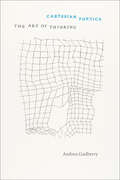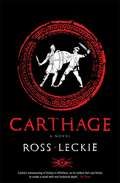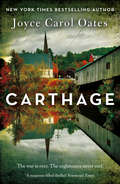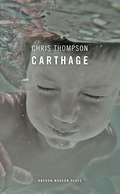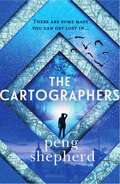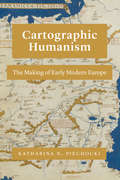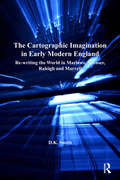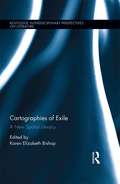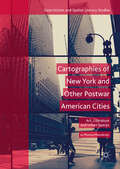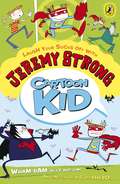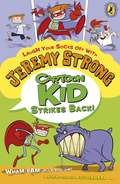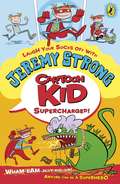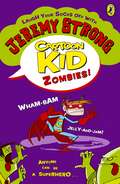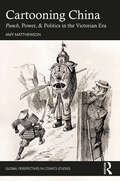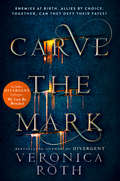- Table View
- List View
Cartesian Poetics: The Art of Thinking (Thinking Literature)
by Andrea GadberryWhat is thinking? What does it feel like? What is it good for? Andrea Gadberry looks for answers to these questions in the philosophy of René Descartes and finds them in the philosopher’s implicit poetics. Gadberry argues that Descartes’s thought was crucially enabled by poetry and shows how markers of poetic genres from love lyric and elegy to the puzzling forms of the riddle and the anagram betray an impassioned negotiation with the difficulties of thought and its limits. Where others have seen Cartesian philosophy as a triumph of reason, Gadberry reveals that the philosopher accused of having “slashed poetry’s throat” instead enlisted poetic form to contain thought’s frustrations. Gadberry’s approach to seventeenth-century writings poses questions urgent for the twenty-first. Bringing literature and philosophy into rich dialogue, Gadberry centers close reading as a method uniquely equipped to manage skepticism, tolerate critical ambivalence, and detect feeling in philosophy. Helping us read classic moments of philosophical argumentation in a new light, this elegant study also expands outward to redefine thinking in light of its poetic formations.
Cartesian Poetics: The Art of Thinking (Thinking Literature)
by Andrea GadberryWhat is thinking? What does it feel like? What is it good for? Andrea Gadberry looks for answers to these questions in the philosophy of René Descartes and finds them in the philosopher’s implicit poetics. Gadberry argues that Descartes’s thought was crucially enabled by poetry and shows how markers of poetic genres from love lyric and elegy to the puzzling forms of the riddle and the anagram betray an impassioned negotiation with the difficulties of thought and its limits. Where others have seen Cartesian philosophy as a triumph of reason, Gadberry reveals that the philosopher accused of having “slashed poetry’s throat” instead enlisted poetic form to contain thought’s frustrations. Gadberry’s approach to seventeenth-century writings poses questions urgent for the twenty-first. Bringing literature and philosophy into rich dialogue, Gadberry centers close reading as a method uniquely equipped to manage skepticism, tolerate critical ambivalence, and detect feeling in philosophy. Helping us read classic moments of philosophical argumentation in a new light, this elegant study also expands outward to redefine thinking in light of its poetic formations.
Carthage (Carthage Trilogy Ser. #3)
by Ross LeckieI fought the Romans once. It no longer seems a prudent thing to do. Carthage concludes the internationally acclaimed trilogy that began with Hannibal and continued with Scipio. Here, Ross Leckie tells of the final Punic War: the story of a great city and a people’s utter eradication under the relentless rise of Rome. But its chief characters, one the bastard son of Hannibal, the other of Scipio, would have wished it otherwise. Both seek peace, but are caught up in war. As they struggle between duty and belief, they stand to lose everything in the face of their fathers’ devastating legacies. Written as a series of letters and entries, the multiple voices of the novel are woven into a masterful exploration of human drives, political intrigue and the process of history making itself.
Carthage: A Novel
by Joyce Carol OatesA young girl’s disappearance rocks a community and a family, in this stirring examination of grief, faith, justice and the atrocities of war, from literary legend Joyce Carol Oates.
Carthage (Oberon Modern Plays)
by Chris Thompson'He was scared shitless every minute he was in there. And he knew. He knew you lot was after him.' Tommy Anderson was born in a prison, and he died in one too. The last moments of his life are recorded on CCTV, and yet no one can answer the simple question: whose fault was it? His mother Anne blames Marcus, the guard who was supposed to be looking after him. Marcus, acquitted by the courts but tormented by his part in Tommy's death, wants the family’s social worker to admit to the role she played. And social worker Sue can’t work out when it was she stopped caring. Piecing together a boy’s life and death in care, Carthage asks who should raise our children when the systems designed to protect them can be as abusive as the situations from which they were rescued.
The Cartographers
by Peng Shepherd'Exquisitely written ... Be prepared to be swept away on an incredible journey' Brad Thor, #1 bestselling author of Black Ice'A story about magical maps that lead to your heart's desire [and] the people who would do anything to find them ... A vastly rich experience' Charles Soule, author of The Oracle YearThere are some maps you can lose yourself in...Nell Young has lived her life in and around maps. Her father, Dr. David Young, was one of the most respected cartographers in the world. But this morning he was found dead - or murdered? - in his office at the New York Public Library. Nell hadn't spoken to her father in years, ever since he fired her after an argument over a seemingly worthless highway roadside map. A map which was mass-produced - and every copy of which is now being found and destroyed. But why? To answer that question, Nell will embark on a dangerous journey into the heart of a conspiracy beyond belief, the secrets behind her family, and the true power that lies in maps . . . THE CARTOGRAPHERS is a story about Art and Science: where they meet, how they both enrich our lives, and how each defines the other. And it's a book about the mystery, history, and ineffable romance of maps.
Cartographic Humanism: The Making of Early Modern Europe
by Katharina N. PiechockiWhat is “Europe,” and when did it come to be? In the Renaissance, the term “Europe” circulated widely. But as Katharina N. Piechocki argues in this compelling book, the continent itself was only in the making in the fifteenth and sixteenth centuries. Cartographic Humanism sheds new light on how humanists negotiated and defined Europe’s boundaries at a momentous shift in the continent’s formation: when a new imagining of Europe was driven by the rise of cartography. As Piechocki shows, this tool of geography, philosophy, and philology was used not only to represent but, more importantly, also to shape and promote an image of Europe quite unparalleled in previous centuries. Engaging with poets, historians, and mapmakers, Piechocki resists an easy categorization of the continent, scrutinizing Europe as an unexamined category that demands a much more careful and nuanced investigation than scholars of early modernity have hitherto undertaken. Unprecedented in its geographic scope, Cartographic Humanism is the first book to chart new itineraries across Europe as it brings France, Germany, Italy, Poland, and Portugal into a lively, interdisciplinary dialogue.
Cartographic Humanism: The Making of Early Modern Europe
by Katharina N. PiechockiWhat is “Europe,” and when did it come to be? In the Renaissance, the term “Europe” circulated widely. But as Katharina N. Piechocki argues in this compelling book, the continent itself was only in the making in the fifteenth and sixteenth centuries. Cartographic Humanism sheds new light on how humanists negotiated and defined Europe’s boundaries at a momentous shift in the continent’s formation: when a new imagining of Europe was driven by the rise of cartography. As Piechocki shows, this tool of geography, philosophy, and philology was used not only to represent but, more importantly, also to shape and promote an image of Europe quite unparalleled in previous centuries. Engaging with poets, historians, and mapmakers, Piechocki resists an easy categorization of the continent, scrutinizing Europe as an unexamined category that demands a much more careful and nuanced investigation than scholars of early modernity have hitherto undertaken. Unprecedented in its geographic scope, Cartographic Humanism is the first book to chart new itineraries across Europe as it brings France, Germany, Italy, Poland, and Portugal into a lively, interdisciplinary dialogue.
Cartographic Humanism: The Making of Early Modern Europe
by Katharina N. PiechockiWhat is “Europe,” and when did it come to be? In the Renaissance, the term “Europe” circulated widely. But as Katharina N. Piechocki argues in this compelling book, the continent itself was only in the making in the fifteenth and sixteenth centuries. Cartographic Humanism sheds new light on how humanists negotiated and defined Europe’s boundaries at a momentous shift in the continent’s formation: when a new imagining of Europe was driven by the rise of cartography. As Piechocki shows, this tool of geography, philosophy, and philology was used not only to represent but, more importantly, also to shape and promote an image of Europe quite unparalleled in previous centuries. Engaging with poets, historians, and mapmakers, Piechocki resists an easy categorization of the continent, scrutinizing Europe as an unexamined category that demands a much more careful and nuanced investigation than scholars of early modernity have hitherto undertaken. Unprecedented in its geographic scope, Cartographic Humanism is the first book to chart new itineraries across Europe as it brings France, Germany, Italy, Poland, and Portugal into a lively, interdisciplinary dialogue.
Cartographic Humanism: The Making of Early Modern Europe
by Katharina N. PiechockiWhat is “Europe,” and when did it come to be? In the Renaissance, the term “Europe” circulated widely. But as Katharina N. Piechocki argues in this compelling book, the continent itself was only in the making in the fifteenth and sixteenth centuries. Cartographic Humanism sheds new light on how humanists negotiated and defined Europe’s boundaries at a momentous shift in the continent’s formation: when a new imagining of Europe was driven by the rise of cartography. As Piechocki shows, this tool of geography, philosophy, and philology was used not only to represent but, more importantly, also to shape and promote an image of Europe quite unparalleled in previous centuries. Engaging with poets, historians, and mapmakers, Piechocki resists an easy categorization of the continent, scrutinizing Europe as an unexamined category that demands a much more careful and nuanced investigation than scholars of early modernity have hitherto undertaken. Unprecedented in its geographic scope, Cartographic Humanism is the first book to chart new itineraries across Europe as it brings France, Germany, Italy, Poland, and Portugal into a lively, interdisciplinary dialogue.
Cartographic Humanism: The Making of Early Modern Europe
by Katharina N. PiechockiPiechocki calls for an examination of the idea of Europe as a geographical concept, tracing its development in the 15th and 16th centuries. What is “Europe,” and when did it come to be? In the Renaissance, the term “Europe” circulated widely. But as Katharina N. Piechocki argues in this compelling book, the continent itself was only in the making in the fifteenth and sixteenth centuries. Cartographic Humanism sheds new light on how humanists negotiated and defined Europe’s boundaries at a momentous shift in the continent’s formation: when a new imagining of Europe was driven by the rise of cartography. As Piechocki shows, this tool of geography, philosophy, and philology was used not only to represent but, more importantly, also to shape and promote an image of Europe quite unparalleled in previous centuries. Engaging with poets, historians, and mapmakers, Piechocki resists an easy categorization of the continent, scrutinizing Europe as an unexamined category that demands a much more careful and nuanced investigation than scholars of early modernity have hitherto undertaken. Unprecedented in its geographic scope, Cartographic Humanism is the first book to chart new itineraries across Europe as it brings France, Germany, Italy, Poland, and Portugal into a lively, interdisciplinary dialogue.
The Cartographic Imagination in Early Modern England: Re-writing the World in Marlowe, Spenser, Raleigh and Marvell
by D.K. SmithWorking from a cultural studies perspective, author D. K. Smith here examines a broad range of medieval and Renaissance maps and literary texts to explore the effects of geography on Tudor-Stuart cultural perceptions. He argues that the literary representation of cartographically-related material from the late fifteenth to the early seventeenth century demonstrates a new strain, not just of geographical understanding, but of cartographic manipulation, which he terms, "the cartographic imagination." Rather than considering the effects of maps themselves on early modern epistemologies, Smith considers the effects of the activity of mapping-the new techniques, the new expectations of accuracy and precision which developed in the sixteenth century-on the ways people thought and wrote. Looking at works by Spenser, Marlowe, Raleigh, and Marvell among other authors, he analyzes how the growing ability to represent physical space accurately brought with it not just a wealth of new maps, but a new array of rhetorical techniques, metaphors, and associations which allowed the manipulation of texts and ideas in ways never before possible.
The Cartographic Imagination in Early Modern England: Re-writing the World in Marlowe, Spenser, Raleigh and Marvell
by D.K. SmithWorking from a cultural studies perspective, author D. K. Smith here examines a broad range of medieval and Renaissance maps and literary texts to explore the effects of geography on Tudor-Stuart cultural perceptions. He argues that the literary representation of cartographically-related material from the late fifteenth to the early seventeenth century demonstrates a new strain, not just of geographical understanding, but of cartographic manipulation, which he terms, "the cartographic imagination." Rather than considering the effects of maps themselves on early modern epistemologies, Smith considers the effects of the activity of mapping-the new techniques, the new expectations of accuracy and precision which developed in the sixteenth century-on the ways people thought and wrote. Looking at works by Spenser, Marlowe, Raleigh, and Marvell among other authors, he analyzes how the growing ability to represent physical space accurately brought with it not just a wealth of new maps, but a new array of rhetorical techniques, metaphors, and associations which allowed the manipulation of texts and ideas in ways never before possible.
Cartographies of Exile: A New Spatial Literacy (Routledge Interdisciplinary Perspectives on Literature)
by Karen Elizabeth BishopThis book proposes a fundamental relationship between exile and mapping. It seeks to understand the cartographic imperative inherent in the exilic condition, the exilic impulses fundamental to mapping, and the varied forms of description proper to both. The vital intimacy of the relationship between exile and mapping compels a new spatial literacy that requires the cultivation of localized, dynamic reading practices attuned to the complexities of understanding space as text and texts as spatial artifacts. The collection asks: what kinds of maps do exiles make? How are they conceived, drawn, read? Are they private maps or can they be shaped collectively? What is their relationship to memory and history? How do maps provide for new ways of imagining the fractured experience of exile and offer up both new strategies for reading displacement and new displaced reading strategies? Where does exilic mapping fit into a history of cartography, particularly within the twentieth-century spatial turn? The original work that makes up this interdisciplinary collection presents a varied look at cartographic strategies employed in writing, art, and film from the pre-Contact Americas to the Renaissance to late postmodernism; the effects of exile, in its many manifestations, on cartographic textual systems, ways of seeing, and forms of reading; the challenges of traversing and mapping unstable landscapes and restrictive social and political networks; and the felicities and difficulties of both giving into the map and attempting to escape the map that provides for exile in the first place. Cartographies of Exile will be of interest to students and scholars working in literary and cultural studies; gender, sexuality, and race studies; anthropology; art history and architecture; film, performance, visual studies; and the fine arts.
Cartographies of Exile: A New Spatial Literacy (Routledge Interdisciplinary Perspectives on Literature)
by Karen Elizabeth BishopThis book proposes a fundamental relationship between exile and mapping. It seeks to understand the cartographic imperative inherent in the exilic condition, the exilic impulses fundamental to mapping, and the varied forms of description proper to both. The vital intimacy of the relationship between exile and mapping compels a new spatial literacy that requires the cultivation of localized, dynamic reading practices attuned to the complexities of understanding space as text and texts as spatial artifacts. The collection asks: what kinds of maps do exiles make? How are they conceived, drawn, read? Are they private maps or can they be shaped collectively? What is their relationship to memory and history? How do maps provide for new ways of imagining the fractured experience of exile and offer up both new strategies for reading displacement and new displaced reading strategies? Where does exilic mapping fit into a history of cartography, particularly within the twentieth-century spatial turn? The original work that makes up this interdisciplinary collection presents a varied look at cartographic strategies employed in writing, art, and film from the pre-Contact Americas to the Renaissance to late postmodernism; the effects of exile, in its many manifestations, on cartographic textual systems, ways of seeing, and forms of reading; the challenges of traversing and mapping unstable landscapes and restrictive social and political networks; and the felicities and difficulties of both giving into the map and attempting to escape the map that provides for exile in the first place. Cartographies of Exile will be of interest to students and scholars working in literary and cultural studies; gender, sexuality, and race studies; anthropology; art history and architecture; film, performance, visual studies; and the fine arts.
Cartographies of New York and Other Postwar American Cities: Art, Literature and Urban Spaces (Geocriticism and Spatial Literary Studies)
by Monica ManolescuCartographies of New York and Other Postwar American Cities: Art, Literature and Urban Spaces explores phenomena of urban mapping in the discourses and strategies of a variety of postwar artists and practitioners of space: Allan Kaprow, Claes Oldenburg, Vito Acconci, Gordon Matta-Clark, Robert Smithson, Rebecca Solnit, Matthew Buckingham, contemporary Situationist projects. The distinctive approach of the book highlights the interplay between texts and site-oriented practices, which have often been treated separately in critical discussions. Monica Manolescu considers spatial investigations that engage with the historical and social conditions of the urban environment and reflect on its mediated nature. Cartographic procedures that involve walking and surveying are interpreted as unsettling and subversive possibilities of representing and navigating the postwar American city. The book posits mapping as a critical nexus that opens up new ways of studying some of the most important postwar artistic engagements with New York and other American cities.
Cartomancy (Gollancz S. F. Ser.)
by Mary GentleMary Gentle is one of Britain's most outstanding writers of imaginative fiction, able to move seamlessly from science fiction to fantasy within the same story. Following on from the success of ASH, 1610: A SUNDIAL IN A GRAVE and the omnibus volumes WHITE CROW and ORTHE, comes CARTOMANCY, the definitive collection of Mary Gentle's short fiction. CARTOMANCY includes the stories from SOLDIERS AND SCHOLARS as well as a number of tales previously unpublished in book form, all with new afterwords and topped and tailed with a specially revised version of her split story 'Cartomancy'.
Cartoon Kid (Cartoon Kid)
by Jeremy StrongYou'll never GUESS what Mr Butternut said at school today:'This is your first day with me and I can see that there is something amazing about you . . . all of you are hiding a BIG SECRET.'And do you know what it is? We are all SUPERHEROES. I nearly fell off my chair! Then we had to choose our superhero names. I'm Casper the Cartoon Kid, my best friend's Big Feet Pete and moaning Noella Niblet - she's the Incredible Sulk!Now we can fight injustice AND Gory and Tory the Vampire Twins. They've stolen something that belongs to us and we want it back - WHAM-BAM-JELLY AND-JAM!
Cartoon Kid - Emergency! (Cartoon Kid)
by Jeremy StrongA new laugh-out-loud adventure in the funny and popular Cartoon Kid series by Jeremy Strong. Casper and his friends have a not-so-well-kept secret . . . they're all SUPERHEROES! That's right; no emergency is moo, sorry, TOO big for Mr Butternut's class, not even a herd of playground invading COWS! And when the school lunch trolley is raided by some pesky packed-lunch robbers, can Casper the Cartoon Kid save the day?Praise for Jeremy Strong:'A real talent for silliness and slapstick' - Sunday Times'Comedy and general fizz are Jeremy Strong's trademarks' - Independent** Three funny stories in one book for 7+ by Jeremy Strong, the award-winning author of The Hundred-Mile-an-Hour Dog and My Brother's Famous Bottom.** Artwork mixed with text and comic strips make this series perfect for reluctant readers.** Sales for Jeremy Strong are now over 7 million copies!** Brilliant revamped Krazy Klub website at jeremystrong.co.uk.
Cartoon Kid Strikes Back! (Cartoon Kid)
by Jeremy StrongCasper and his friends have an amazing ZEEOWWW! WHIZZ! SPLATT! secret - THEY ARE ALL SUPERHEROES!Which will come in very handy this Sports Day when a dog named JAWS is let off his lead. . . AARRGHHH!And what happens when Casper's vacuum cleaner swallows a HAMSTER? Find out in not just one, but THREE Cartoon Kid adventures. WHAM-BAM-JELLY-AND-JAM!
Cartoon Kid - Supercharged! (Cartoon Kid)
by Jeremy StrongMEET CASPER! By day he's a regular school kid but by . . . later on in the day he's CARTOON KID!That's right - Casper is a SUPERHERO - but shhhhhh, keep it quiet because it's a SECRET! Casper, Big Feet Pete and Sarah Sitterbout are in for a shock when a MONSTROUS new teacher arrives. She says her name is Mrs Cloddle - ha! - CLODZILLA more like. Cartoon Kid to the rescue!And that's just ONE of their adventures in this laugh-out-loud book . . . WHAM BAM JELLY AND JAM!
Cartoon Kid - Zombies! (Cartoon Kid)
by Jeremy StrongAARGH - the school inspectors have arrived! There's trouble at school, but Casper and his friends have an out-of-this-world secret . . . THEY'RE ALL SUPERHEROES! Masher McNee and his monster zombie mob are no match for their extra-special powers in the playground. WHAM-BAM-JELLY-AND-JAM!With a snoring zombie giving Casper sleepless nights, and a gruesome discovery for show-and-tell, the Cartoon Kid is ready for anything - dead or alive!SPLUDDD!!!SPINNG!!!!BOOFFF!!!!!** Three funny stories in one book for 6+ by Jeremy Strong, the award-winning author of The Hundred-Mile-an-Hour Dog and My Brother's Famous Bottom.** www.jeremystrong.co.uk** Perfect for fans of Diary of a Wimpy Kid by Jeff Kinney, and Liz Pichon's The Brilliant World of Tom Gates.
Cartooning China: Punch, Power, & Politics in the Victorian Era (Global Perspectives in Comics Studies)
by Amy MatthewsonThis book explores the series of cartoons of China and the Chinese that were published in the popular British satirical magazine Punch over a sixty-year period from 1841 to 1901. Filled with political metaphors and racial stereotypes, these illustrations served as a powerful tool in both reflecting and shaping notions and attitudes towards China at a tumultuous time in Sino-British history. A close reading of both the visual and textual satires in Punch reveals how a section of British society visualised and negotiated with China as well as Britain’s position in the global community. By contextualising Punch’s cartoons within the broader frameworks of British socio-cultural and political discourse, the author engages in a critical enquiry of popular culture and its engagements with race, geopolitical propaganda, and public consciousness. With a wide array of illustrations, this book in the Global Perspectives in Comics Studies series will be an important resource for scholars and researchers of cultural studies, political history and Empire, Chinese studies, popular culture, Victoriana, as well as media studies. It will also be of interest to readers who want to learn more about Punch, its history, and Sino-British relations.
Cartooning China: Punch, Power, & Politics in the Victorian Era (Global Perspectives in Comics Studies)
by Amy MatthewsonThis book explores the series of cartoons of China and the Chinese that were published in the popular British satirical magazine Punch over a sixty-year period from 1841 to 1901. Filled with political metaphors and racial stereotypes, these illustrations served as a powerful tool in both reflecting and shaping notions and attitudes towards China at a tumultuous time in Sino-British history. A close reading of both the visual and textual satires in Punch reveals how a section of British society visualised and negotiated with China as well as Britain’s position in the global community. By contextualising Punch’s cartoons within the broader frameworks of British socio-cultural and political discourse, the author engages in a critical enquiry of popular culture and its engagements with race, geopolitical propaganda, and public consciousness. With a wide array of illustrations, this book in the Global Perspectives in Comics Studies series will be an important resource for scholars and researchers of cultural studies, political history and Empire, Chinese studies, popular culture, Victoriana, as well as media studies. It will also be of interest to readers who want to learn more about Punch, its history, and Sino-British relations.
Carve the Mark (Carve the Mark #1)
by Veronica RothFans of Star Wars and Divergent will revel in internationally bestselling author Veronica Roth’s first title in a stunning new science-fiction fantasy series.
